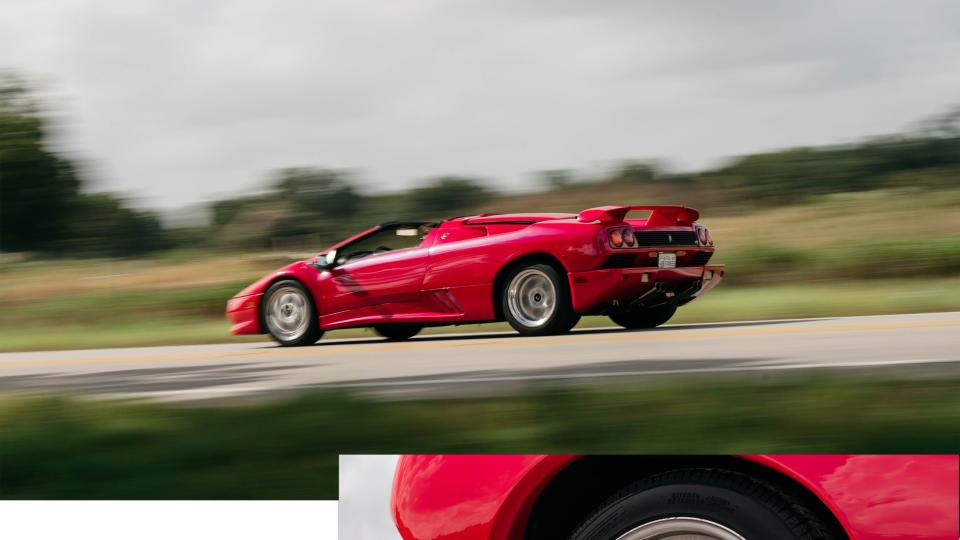Driving a Pink Lamborghini Diablo VT Showed Me Why Supercars Aren't Silly Anymore


The silly supercar is dead. Today’s lot are in varying amounts sensational, precise, refined, ostentatious, aggressive, over-the-top, and brightly colored, but they aren’t whimsical. They’re super versions of normal cars, and excellent because of it. A Lamborghini Diablo VT, however, is something entirely different.
In the Diablo absurdity is a mission, not a side effect. Its bones were outdated 20 years ago, and ancient now, the budget spent instead on styling that still demands attention today. It pairs the beltline of a toddler with the menacing girth of a Raptor. The driver sits close to the knifepoint nose, the majority of the Lambo’s considerable length dedicated to its engine bay.
Inside it lives a 5.7-liter V-12. It breathes air at atmospheric pressure. It uses a 16-bit computer to run its injectors. Everything is synchronized to produce the loudest, best noise imaginable. The waste product of the production process is 492 hp and 428 lb-ft of torque.

Our tester was a gorgeous Rosso Targa 1996 model that biased even more toward theatrics, thanks to a cat-back exhaust. According to DriverSource, the classic car seller offering this model on Bring a Trailer, the Diablo was straight-piped in a previous life. The cats were added back in to quiet the V-12 down. That a louder car is even possible strains credulity. On startup, I felt God’s own bass drum thumping in my chest. On fly-bys, I expected to hear air raid sirens in the distance.
The sound was made sweeter by the Diablo’s open-air cabin. This model is a convertible, as all Diablos should be. True, this Lamborghini hails from a time before carbon tubs, when opting for the drop-top came with a significant penalty in rigidity. But if you’re buying a Lamborghini from the Nineties, that’s hardly your primary concern.
Because driving a Diablo isn’t about honing your skills with a precision-crafted instrument. It is a wrestling match in the mud. You fight with the clunky shifter, its gate the only thing guiding the vague action. You slip around on the pedals, crammed as they are into the top right corner of the pedal box. You browbeat the brakes because they won’t respond to anything less. You chuck it into a corner, and then adjust three times as you negotiate with the steering wheel.

It is consistent, and predictable, but it is not easy. Speed requires patience and bravery. On a limited drive through back roads around Houston, I lacked either in sufficient quantities to fall into sync with the VT. It didn’t matter. I emerged from my short drive drenched in sweat, both from the weakness of the Diablo’s air conditioning in the Texas heat and the concentration required to keep the Lamborghini on boil. I hadn’t won the match, but I came out alive, exhausted, and satisfied.
The experience was wholly different from what a modern supercar offers. Today’s Lamborghinis are far faster, far more composed, and far more trustworthy. They’re also far closer to normal cars. Their infotainment systems are thoughtful Audi units. Their air conditioners are powerful. Their true powers are roped off behind layers of stability and traction control, and accessed by the machinations of automated transmissions. The doors on the V-12 one still open upward, but have enough hydraulic assistance to make that motion easy, graceful even.
The Diablo’s doors require some forearm force. Air conditioning does not blow, it wheezes out of vents too far away to provide any noticeable cooling effect with the top down. The controls are laid out nonsensically. The gauges are analog, shaky, and in this 23,000-mile example occasionally show worryingly high oil pressure. The battery indicator came on because, as we later found out, the alternator had failed. (It has since been replaced.) The whole thing smelled of too-hot plastic. Getting the dog-leg shifter into reverse required semi-truck effort. Everything, really, felt simultaneously brutish and delicate. Most cars require muscle or finesse. The Diablo asks for both.

There is no a-ha moment when everything clicks, at least not in my short time with the Diablo. After driving hundreds of cars, I can usually find my rhythm with one after a mile or two, settling into the quirks of its gearbox, throttle response, or brakes. My brain switches from the slow, deliberate actions of Cognitive System 2 into the automatic, instinctive operation of Cognitive System 1.
The Diablo resists this handoff. It is not meant to be driven automatically, or carelessly. It wants not just your involvement but your attention. You don’t listen to the radio, or day dream. You drive, and you react to the Diablo as it goes. Mostly it is predictable and friendly enough to be enjoyable; sometimes it lives up to its name.
It is a bi-directional relationship, more human than your average car. It is not an uncomplaining tool. It does not just give, it also takes. It frustrates and confuses you, but also amazes and excites you. Each experience with it carries risks and complications, but they are all memorable. They are all unique.

That’s not true of the modern set. The experience is holistically better, but it is also the same every time. In the endless need to increase sales and profits, the mainstream supercar has become a mass-market good. It must be idiot-proofed, drivable in conditions that no supercar should ever see, and self-regulating. Lamborghini in 2023 cannot expect its buyer to keep an eye on an oil pressure gauge. The company cannot demand mechanically sympathy.
Supercar buyers don’t want to sacrifice. And I can’t blame them. If I were spending $400,000 on an Aventador, or 720S, I’d want a real air conditioner. I’d want it to work in traffic. I’d want comfortable seats, and a nice suspension, and room for my stuff, and cupholders. But if you give the buyer everything they want in an everyday car, your supercar starts to feel quite normal.
True greatness requires sacrifice. A supercar’s personality does not come from its stats or its performance, it comes from the car’s ability to strip away everything but the experience. A car that anchors you in the moment.

There are two ways to do that. The first is by making the car perfect. That is the approach of the 911 GT3 and the Ferrari 550 Maranello, a focus on precision and excellence that’s valued even today.
But the Diablo does it in another way. It commands your full attention because it is unhinged. It is not logical or thoughtful. It is wild and temperamental. It shouts and squirms and occasionally throws fluids all over the ground. If you’re not willing to deal with it, don’t take it for a ride.
I can see why this breed died out. People have long preferred the impression of wilderness to the actual experience, which is why today’s exotics appear even more menacing on paper. In the hot seat, though, they are just cars that are fast. The Diablo is something more. It's a supercar.

You Might Also Like

 Yahoo Autos
Yahoo Autos 